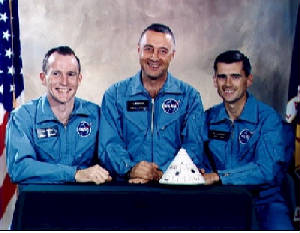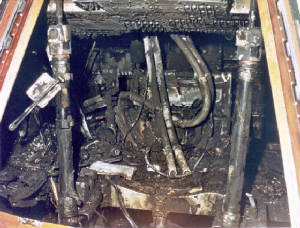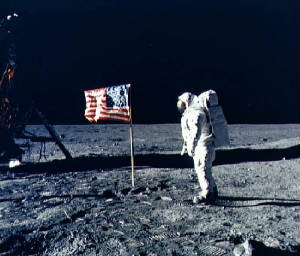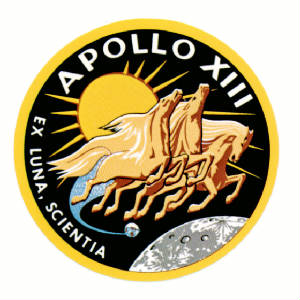|
Goals of the program
1.land Americans on the moon and bring them back safely
2.create new technology in space
3.achieve preminence
4.intense science research on the moon
5.develop man's ability to work on the moon
The Training
-in 1959 seven men were chosen for the program
-another nine in 1962 and then another fourteen
-first group were test pilots with engineering degrees
-1966 another nine were chosen
-training was more intense than Gemini or Mercury
-studied celestial bodies and moon navigations
-survival training in deserts, rain forest areas similar to lunar areas, in 1/6 gravity trainers, recovery routines
-President Kennedy wanted to land a man on the moon by the end of the 1960s
-December 1968 Saturn IB was discarded and the Saturn V was adopted for Apollo 8
-three stages
-first stage equaled the height of thw hole Saturn IB
-Saturn V had five engines

Apollo 1
scheduled to launch February 21, 1967
astronauts: Gus Grissom, Roger Chaffee, Edward White
-training exercise January 27
-in the capsule for 5 hours
-an electrical fire
-capsules air was pure oxygen so the fire grew
-all astronauts were lost
-this tragedy taught us to have a mixed gas cabin

Apollo 4,5,6
-unpiloted test flights in 1967 and 1968
-Apollo 4 first Saturn V test flight
-Apollo 5 first lunar module test flight
-Apollo 6 April 4, 1968 unpiloted dress rehearsel
-helped putting Apollo hardware into orbit
-there were problems(fuel flow problems, engine failures in Saturn launcher)
-improved in the next Apollo missions
Apollo 7
October 11-22, 1968
astronauts:Wally Schirra,Donn Eiesle,Walter Cunnigham
-launched by a Saturn IB
-first piloted launch of Apollo
-lasted eleven days
-163 earth orbits
-tested
-guidance and control systems
-new design for a spacesuit
-work-rest-sleep routine
Apollo 8
December 21-27,1968
astronauts:Frank Borman,James Lovell,William Anders
-first human lunar orbital flight
-most important achievement pre-moon landing
-147 hours long
-first astronauts to see the whole Earth from space and the other side of the moon
-first to get away from Earth's gravitational force and into the moon's force of gravity
-put America leader of the space race
Apollo 9
March 3-13,1969
astronauts:James McDivitt, David Scott, Rusty Schweickart
-first test of the lunar module (spider)
-command module (gumdrop)
-landed after 151 orbits
-lunar module flew alone from the main craft for six hours
-space walk in new lunar space suit with a buit-in backpack life-support system
Apollo 10
May 18-26,1969
astronauts:Thomas Stafford,John Young,Eugene Cernan
-lunar module (Snoopy)
-command module (Charlie Brown)
-wanted to test Snoopy's navigational power in the gravitational force of the moon
-brought lunar module nine miles close to where Apollo 11 would soon land
-landed in the South Pacific
-192 hours
-in weeks man would be on the moon

Apollo 11
July 16-24,1969
astronauts:Neil Armstrong,Buzz Aldrin, Michael Collins
-lunar module (Eagle)
-command module (Columbia)
-on far side of the moon lost contact with Houston for 33 minutes
-when connection was remade Armstrong said, "The eagle has wings"
-Aldrin and Armstrong in the lunar module
-"The Eagle has landed" -Buzz Aldrin
-after six and a half hours on the moon Armstong took the first step on the moon
-took a small sample of dirt in case of emergency and quick take off
-after an hour Aldrin joined him
-worked for ninety minutes
-48.5lbs of moon soil and rock were collected
-conducted experiments
-measure tremors and measured Moon-Earth distances better
-placed and American flag and had a telephone call from Richard Nixon (president)
-Aldrin's description "magnificent desolation"
-post landing back on Earth they were quarantined for three weeks
-making sure no weird microbes had been brought back
-celebrated everywhere

Apollo 12
November 14-24,1969
astronauts:Charles Conrad,Richard Gordon,Alan Bean
lunar module (Intrepid)
-command module (Yankee Clipper)
-struck by lightning twice a minute after launch
-no damage
-31.5 hours on the moon
-first colour TV pictures
-lunar module crashed to the surface of the moon at 5000miles/hour
-first artificial "moonquake"

Apollo 13
April 11-17,1970
astronauts:James Lovell,John Swigert,Fred Haise
-lunar module (Aquarius)
-command module (Odyessy)
-56 hours into trip on April 13,1970 oxygen tank exploded and hurt a control paned with tanks and systems within
-no oxygen,water or power from Odyessy
-circled moon and back to Earth
-low oxygen and not much power
-lunar module had enough oxygen for two people for 50 hors
-saved three people for 95 hours
-it was cold and not much water
-crashed down int the Pacific on April 17
"Apollo 13 must officialy be classed as a failure...But in another sense as a brilliant demonstration of the human
capability under almost unbearable stress, it has to be the most successful failure in the annals of spaceflight"
Apollo 14
January 31-February 9,1971
astronauts:Alan Shephard,Stuart Roosa, Edgar Mitchell
-lunar module (Antares)
-command service module (Kitty Hawk)
-Shephard at 47, oldest man to walk o the moon
-Shephard's heart rate picked up and the first space rest period was ordered
-brought golf club and two golf balls
-hit one 180m and the other 365m
-spent more than nine hours collecting specimens
-brought back 96lbs of lunar rock
Apollo 15
July 26-August 7,1971
astronauts:David Scott, Alfred Worden,James Irwin
-lunar module (Falcon)
-command service module (Endeavour)
-first to use the lunar roving vehicle
-collapsible
-rover left behind to be used in Apollo 16 and 17 missions
-completed three EVAs
Apollo 16
April 16-27,1972
astronauts:John Young,Thomas MattinglyII,Charles Duke
-lunar module (Orion)
-command service module (Casper)
-three EVAs were completed
-small astronomical observatory
-rover visited several craters
Apollo 17
December 7-19,1972
astronauts:Eugene Cernan,Ronald Evans,Harrison Schmitt
-lunar module (Challenger)
-command service module (America)
-longest time on the moon, 75 hours
-some of the best maps of the moon
Further moon missions
Clementine
-unpiloted moon mission after Apollo 17 in 1972
-lunar orbit in February 1994
-lunar map completed June 1994
-pictures put together to create panoramics of the moon
-also used to pick out rock types
|

